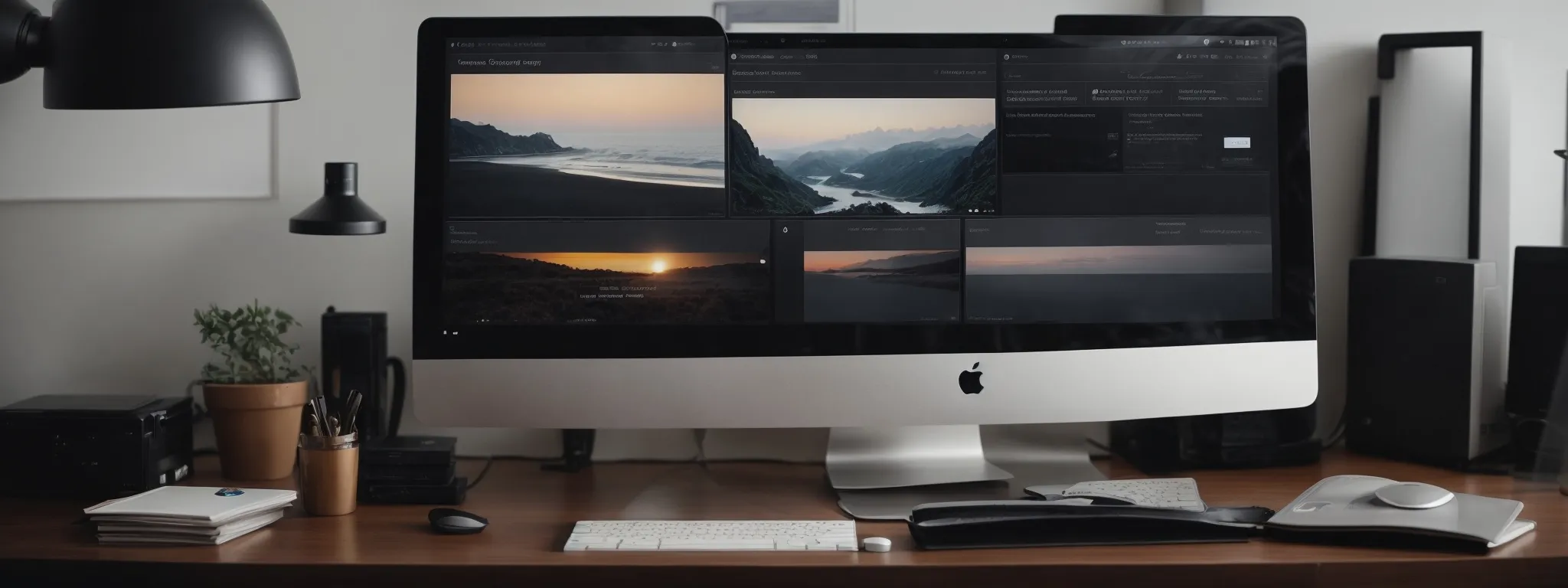Google Shares SEO Tips: Single Page Apps
Maximizing Visibility: SEO Strategies for Single Page Apps by Google In an era where user experience reigns supreme, Single Page Applications (SPAs) have become the architecture of […]
Maximizing Visibility: SEO Strategies for Single Page Apps by Google
In an era where user experience reigns supreme, Single Page Applications (SPAs) have become the architecture of choice for many developers.
Yet, their dynamic nature poses unique challenges to search engine optimization.
As the digital landscape evolves, so too must the strategies used to ensure these applications rank well in search results.
LinkGraph’s comprehensive guide to SEO for SPAs combines best practices with innovative techniques to maximize visibility and improve search performance.
Keep reading to unravel the techniques that will propel your single page web application to the forefront of Google’s search results.
Key Takeaways
- Single Page Applications Face Unique SEO Challenges, Such as JavaScript-heavy Content Affecting Search Engine Indexing
- Server-Side Rendering Is a Critical Strategy for Enhancing SPA SEO and Ensuring Content Is Accessible to Search Crawlers
- LinkGraph’s SEO Services Offer Solutions to SPA SEO Issues, Leveraging Tools Like the History API and Structured Data for Better Indexing
- Properly Optimized Single Page Applications Can Achieve Both Seamless User Experience and High Search Engine Visibility
- Advanced SEO Techniques and Continuous Performance Tracking Are Essential for SPAs to Maintain and Improve Their Online Presence
Understanding SEO Implications for Single Page Apps

As the digital landscape evolves, developers increasingly embrace Single Page Applications (SPAs) for their seamless user experience and responsive design.
Yet, these SPA pages confront specific challenges when it comes to Search Engine Optimization.
Since Googlebot and other search engines rely on certain elements to crawl and index content effectively, the typical SPA can present roadblocks.
The imperative for businesses seeking online prominence extends to comprehending the basic nuances of SPA SEO.
This undertaking spans identifying common indexing pitfalls inherent in SPA setups to acknowledging the pivotal role that Server-Side Rendering (SSR) plays.
A studied approach to SEO ensures that the user-centric perks of SPAs do not come at the cost of search engine invisibility.
The Basics of SPA SEO
In the domain of web development, the optimization of Single Page Applications (SPAs) presents unique SEO challenges that warrant a meticulous approach. Unlike traditional multi-page sites, SPAs serve content dynamically from a single HTML page, making the task of search engine crawlers more complex.
Key to addressing these challenges is an understanding of the interaction between the search engine bots and the various SPA components: from the importance of meta tags and SEO-friendly URLs to the role of backend server configuration.:
- Ensuring that meta tags are dynamically generated and appropriate for each view or state of the application.
- Crafting URLs that are not only user-friendly but also conducive to being understood by search engines.
- Configuring the server to return the correct status code, a fundamental signal for the search engine crawlers.
Common Indexing Issues in SPAs
Single Page Applications often encounter SEO issues stemming from the inability of search crawlers to adequately index JavaScript-heavy content. These applications rely heavily on client-side JavaScript to render page content, creating a dependency on search engines’ ability to execute and interpret scripts effectively.
This often results in search engine crawlers, like Googlebot, facing difficulty discovering and indexing the content when it’s delivered predominantly through JavaScript. To alleviate such SEO bottlenecks, LinkGraph’s SEO services expertly intervene, implementing workarounds that improve the visibility of SPA content:
| SPA SEO Challenge | LinkGraph’s SEO Solutions |
|---|---|
| JavaScript Rendering | Server-Side Rendering (SSR) Implementation |
| Dynamic Content Indexing | Meta Tags Optimization & Sitemap Generation |
| SPA Crawl Efficiency | Client-Side Hydration Techniques |
Importance of Server-Side Rendering
Server-Side Rendering (SSR) emerges as a critical component in enhancing the Search Engine Optimization for Single Page Applications. By prerendering the SPA content on the server, SSR ensures that search engine crawlers, including Googlebot, can access an HTML page rich with indexable content upon their initial visit, paving the way for improved SEO performance.
By integrating SSR, LinkGraph’s SEO services prioritize the delivery of content in a form congruent with search engine preferences, thereby aiding in the seamless indexing of SPA pages. This strategic adjustment not only preserves the user experience intrinsic to SPAs but also aligns it with the operational paradigms of search crawlers, ensuring comprehensive visibility for a client’s web application.
Implementing Google’s Best Practices for SPAs

To gain a competitive edge, Single Page Applications must adeptly navigate the nuances of SEO, aligning their streamlined, user-centric design with the intricate requirements of search engine crawlers.
Google’s best practices provide a beacon for such digital entities, emphasizing the criticality of streamlining content delivery to ensure indexability, leveraging the History API for fluid navigation, and optimizing metadata for crawler accessibility.
Embracing these guidelines propels SPAs towards higher visibility, carving a path for transformative search results presence that LinkGraph’s SEO services are well-equipped to guide.
Streamline Content Delivery for Indexability
LinkGraph’s adept tactics in streamlining content delivery are instrumental in elevating the indexability of Single Page Applications. Their expertise facilitates an efficient server-to-search engine dialogue, ensuring that essential content is readily consumable by search engine bots, bolstering the web app’s search result traction.
A critical part of this strategy involves the rigorous optimization of backend operations, complemented by the careful orchestration of page content rendering. This ensures that each website page communicates effectively with search crawlers, seamlessly combining the benefits of SPA’s interactivity with robust SEO foundations.
Use History API for Navigation
LinkGraph’s specialization in SEO strategizes the deployment of the History API, a robust tool for SPAs to manage the navigation history akin to traditional web pages. This practice, endorsed by Google, enables single page websites to maintain SEO-friendly URLs, substantially enhancing their navigation structure for optimal search crawler interpretation and user engagement.
Through the meticulous integration of the History API, LinkGraph ensures that each transition within the web app registers a unique, meaningful URL. This level of detail captures the essence of user interactions, presenting to search engine bots a semantically rich terrain that favors the indexing of a SPA’s diverse states while retaining its dynamic, immersive user experience.
Ensure Metadata Is Accessible to Crawlers
In the quest to enhance SPA SEO, LinkGraph reinforces the accessibility of metadata for search crawlers: a pivotal step towards ensuring comprehensive indexing. By optimizing meta tags and implementing structured data, they render essential information detectable by search engine bots, promoting an accurate representation of the web application in search results.
- Optimization of meta tags for richer snippets and improved click-through rates.
- Structured data insertion to yield enhanced search engine understanding and display.
- Meticulous verification of metadata to ensure alignment with content strategies.
Crucial to the process is the consistent update and validation of metadata elements across SPA pages, ensuring that they reflect the current state and content presented to the user. LinkGraph’s expertise extends to maintaining this dynamism, a key factor in fostering a positive relationship between the SPA and search engine crawlers for sustained SEO success.
Enhancing User Experience With SEO in Mind

In a digital environment where immediacy and convenience govern user choices, Single Page Applications (SPAs) must not only be optimized for search engine visibility but also for an exceptional user experience.
To ensure that SPAs meet the high standards of today’s mobile-first world, it is imperative to consider several key initiatives: optimizing loading times to enhance rankings, designing a navigable SPA structure for seamless user interaction, and ensuring mobile responsiveness to cater to the majority of web users.
Tackling these aspects is paramount in crafting an SPA that not only resonates with customers but also secures its prominence on search result pages.
Optimize Loading Times for Better Rankings
In the competitive digital milieu, optimizing loading times becomes crucial for enhancing a website’s search rankings. Single Page Applications (SPAs), known for their swift user interactions, must prioritize rapid content delivery to secure favorable positions in search result listings.
| SEO Focus Area | Impact on SPAs | LinkGraph’s Optimization Strategy |
|---|---|---|
| Loading Speed | Direct influence on user retention and search ranking | Implementation of code-splitting and lazy loading techniques |
| Resource Optimization | Enhanced page load performance and responsiveness | Streamlining of assets and reduction of server response times |
LinkGraph recognizes that a swift loading SPA not only captivates users but also attracts the meticulous gaze of search engine algorithms. Their expertise in refining code efficiency and leveraging advanced caching manifests in load times that ignite user engagement and propel websites up the search engine ladder.
Create an Easily Navigable SPA Structure
LinkGraph’s strategic approach to sculpting Single Page Applications includes refining the structure to enhance navigability, ensuring that each user’s journey through a website is intuitive and hurdle-free.
Recognizing the potential for complexity in SPAs, LinkGraph meticulously streamlines the web application’s architecture, thereby simplifying the navigation process and enriching the overall user experience while staying in harmony with the stringent requisites for robust SEO.
Prioritize Mobile Responsiveness for SPAs
In the pervasive realm of mobile browsing, the importance of crafting Single Page Applications (SPAs) with mobile responsiveness at the forefront is undeniable. LinkGraph employs strategies that ensure SPAs display flawlessly across all devices, a critical facet for retaining user engagement and satisfying the mobile-first indexing strategies of search engines.
Conscious of the impact mobile responsiveness has on search engine rankings, LinkGraph’s SEO services focus on crafting SPAs that offer an unrivaled user experience, irrespective of the device. Such dedication to responsive design not only caters to the convenience of users but also echoes the standards set forth by Google for optimum online visibility.
Leveraging JavaScript Frameworks for SEO Benefits

In the quest to elevate single page applications (SPAs) through the intricate lens of search engine optimization, the selection of an SEO-friendly JavaScript framework becomes vital.
These frameworks form the backbone of many SPAs, and the choice can significantly influence how search crawlers interact with page content.
Experts at LinkGraph adeptly navigate the JavaScript terrain, identifying frameworks that bolster SEO while steering clear of common pitfalls that hinder SPA visibility.
Incorporating structured data further into these frameworks, LinkGraph empowers businesses to illuminate their content thus ensuring that every nugget of information is recognized and valued by search engines.
Choosing SEO-friendly JavaScript Frameworks
When it comes to creating SEO-optimized Single Page Applications, the selection of a JavaScript framework is a critical decision that can make or break a site’s visibility. LinkGraph’s seasoned specialists often recommend frameworks known for their search engine friendliness, such as React or Angular, which offer server-side rendering capabilities to help ensure content is fully accessible to search crawlers upon initial page load.
Employing a JavaScript framework that integrates seamlessly with SEO best practices allows developers to maintain the dynamic interactivity of SPAs without sacrificing their search engine ranking potential. LinkGraph’s expertise guides clients through the maze of technical choices, ensuring the framework lays a sound foundation for a robust SEO strategy tailored to a website’s specific needs.
Avoiding Common Pitfalls in JavaScript-heavy SPAs
Navigating the complexities of SEO in JavaScript-heavy Single Page Applications (SPAs) demands attention to avoid common pitfalls that can obscure a site from search crawlers. One such pitfall is the over-reliance on client-side JavaScript for rendering content, which can impede the ability of Googlebot and other crawlers to fetch and index the site’s content effectively upon the initial load.
LinkGraph, with its comprehensive SEO services, facilitates the development of SPAs that preempt potential issues by ensuring that content is server-side rendered where necessary. This strategy permits search engine crawlers to parse and index content without delay, remarkably enhancing the SPA’s visibility and searcher accessibility in Google’s search results.
Enhance Content Visibility With Structured Data
Structured data implementation is a leading tactic in boosting the visibility of content within Single Page Applications (SPAs). LinkGraph meticulously incorporates rich snippets through schema markups, providing search engine bots with a deeper understanding and a more detailed preview of the content, which can result in a more prominent and enhanced display within search results.
Through structured data, LinkGraph’s SEO services elevate the clarity with which a web application communicates its content to search engine crawlers. This strategic approach enables SPAs to stand out, simplifying the process for search crawlers to index the core items and narratives pivotal to a client’s product or service offerings.
Tracking and Analyzing SPA Performance for SEO

In the pursuit of securing top-tier positions in Google’s search landscape, Single Page Applications (SPAs) must not only be impeccably designed but also meticulously tracked and analyzed for SEO performance.
Shrewd web developers enlist a spectrum of tools and techniques tailored for SPA SEO analysis, diving deep into a realm of metrics and insights that inform strategic improvements.
The art of interpreting SPA analytics for SEO enhancement is integral to refining user journeys, while the implementation of progressive web app features heightens the precision of tracking mechanisms.
Such sophisticated analysis is vital for businesses to solidify their online presence, ensuring that every facet of their web application is aligned with Google’s discerning algorithms.
Tools and Techniques for SPA SEO Analysis
Accurate tracking and productive analysis of SEO performance for Single Page Applications (SPAs) require a sophisticated set of tools and techniques; without them, businesses may remain in the dark about their online visibility. LinkGraph utilizes an array of advanced analytics tools, including their proprietary SearchAtlas SEO tool, to dissect and understand the intricacies of SPA SEO: evaluating everything from user engagement signals to performance metrics that influence search rankings.
| SEO Metric | Analysis Tool | Value to SPA SEO |
|---|---|---|
| Page Load Time | SearchAtlas SEO Tool | Serves as an indicator of user experience quality and impacts search engine rankings. |
| Crawl Errors | Google Search Central | Identifies issues that prevent search crawlers from indexing SPA content effectively. |
| Organic Traffic | SearchAtlas SEO Tool | Measures success in capturing user searches and evaluates overall SEO performance. |
To complement these tools, LinkGraph employs techniques suited for single page websites, such as A/B testing, to tweak on-page elements and enhance the corresponding response from search engine crawlers. By actively monitoring the performance of meta tags and SEO friendly URLs, LinkGraph ensures SPAs are consistently optimized for peak performance in search results.
Interpreting SPA Analytics for SEO Improvement
Mastering the art of SEO for Single Page Applications necessitates a deep dive into analytics, where LinkGraph’s strategy shines in its capacity to interpret user behavior and search engine feedback into actionable insights. The firm’s proficiency enables clients to adjust their SPA strategies, ensuring that search engines like Google can effortlessly navigate and favor their content.
At the core of LinkGraph’s analytical prowess lies an emphasis on the efficacy of their clients’ web apps. By continuously analyzing performance data, LinkGraph tailors SEO tactics that directly influence a single page website’s visibility, ultimately fine-tuning the site’s architecture to satisfy both search crawler algorithms and user search intent.
Setting Up Progressive Web App Features for Enhanced Tracking
Progressive Web App (PWA) features are an essential inclusion for Single Page Applications looking to refine tracking capabilities within their SEO strategies. LinkGraph harnesses these features to bridge the gap between web and mobile app experiences, offering a rich set of analytics that delivers granular insight into user interactions and engagement levels.
The incorporation of PWA elements by LinkGraph enables precise monitoring, allowing for real-time data analysis and the capturing of offline user activities, which are critical for understanding the full scope of SPA performance from an SEO perspective. This sets the foundation for data-driven decisions that can escalate a single page application’s prominence in Google search rankings.
Advanced Techniques for Maximizing SPA Visibility

In an ever-evolving digital marketplace, businesses with Single Page Applications (SPAs) seek advanced methodologies to enhance their online visibility amidst the competition.
Implementing cutting-edge SEO techniques such as Lazy Loading, integrating Accelerated Mobile Pages (AMP), and leveraging Pre-Rendering services are integral to propelling SPAs into the spotlight.
Each strategy presents a refined approach to SEO, meticulously aligning with the core objective of maximizing a web application’s presence in Google search results, thus ensuring that these dynamic, user-centric platforms achieve the recognition and reach they deserve.
Implementing Lazy Loading With SEO Best Practices
Single Page Applications (SPAs) that implement lazy loading techniques must do so with a strategic approach to SEO. The practice entails deferring the loading of non-critical resources at page load time, thus enhancing the speed and user experience without compromising the content’s indexability and visibility.
By prioritizing above-the-fold content and ensuring key SEO elements are immediately available to search engine crawlers, LinkGraph tailors lazy loading implementations to accommodate the demands of both users and search algorithms:
| SEO Component | Lazy Loading Consideration | Benefits of LinkGraph’s Approach |
|---|---|---|
| Page Load Speed | Immediate loading of critical assets | Quicker interactions leading to improved user retention and SEO performance. |
| Content Visibility | Indexable content remains at the forefront | Ensures search crawlers can easily discover vital content, boosting SPA rankings. |
LinkGraph’s insightful integration of lazy loading champions the balance between streamlined user experience and the necessary technical SEO framework. This caters to the dual preference of rapid access for users and complete accessibility for search engine crawlers.
Utilizing Accelerated Mobile Pages (AMP) With SPAs
The integration of Accelerated Mobile Pages (AMP) within Single Page Applications (SPAs) is a strategic move by LinkGraph, aiming to enhance the mobile user experience through fast-loading page features. By adopting AMP, LinkGraph ensures that SPAs benefit from increased loading speed and optimization, crucial for capturing the attention of mobile users and improving a site’s standing in mobile search results.
Through this fusion of SPA and AMP technologies, LinkGraph harnesses AMP’s streamlined approach to rendering web pages, increasing the likelihood of higher engagement rates and reduced bounce rates. The result is an SPA that not only delivers content swiftly but also aligns with Google’s mobile-first indexing, further solidifying its position in the competitive realm of search engine rankings.
Harnessing the Power of Pre-Rendering Services
Pre-rendering services offer Single Page Applications (SPAs) a vital edge in boosting visibility, by generating static HTML versions of dynamic pages this technique ensures content is readily accessible to search engine crawlers. The adoption of pre-rendering can significantly diminish the latency of content visibility, permitting search crawlers more immediate access to critical SPA content: a significant stride given the crawler’s time-budgeted nature.
- Pre-rendered content bridges the gap between dynamic JavaScript execution and the search engine crawler’s immediate content needs.
- LinkGraph capitalizes on pre-rendering to bolster SPA search engine exposure, enhancing a website’s capacity to manifest prominently within search results.
- This strategic maneuver greatly diminishes the SEO obstacles commonly faced by client-side rendered SPAs.
LinkGraph leverages pre-rendering services to preempt SEO challenges, delivering a turnkey solution that circumvents delays in JavaScript-rendered content discovery. Harnessing pre-rendering not only amplifies an SPA’s search engine friendliness but also paves the way for wider content distribution across the digital ecosystem, ensuring users and search engines alike can engage with a client’s valuable content posthaste.
Conclusion
Maximizing visibility through SEO for Single Page Applications (SPAs) is essential for ensuring these dynamic platforms rank well in search results and reach their targeted audience effectively.
Given the unique structure of SPAs that rely heavily on JavaScript, it’s imperative to adopt specific SEO strategies that cater to their particular needs.
Effective strategies include implementing server-side rendering (SSR) to allow search crawlers to access content immediately, optimizing meta tags and URLs for SEO, and using the History API to maintain user-friendly navigation.
Techniques like lazy loading should be adapted carefully to prioritize critical content and maintain loading speed without sacrificing indexability.
In addition to technical adjustments, it’s necessary to choose SEO-friendly JavaScript frameworks, such as React or Angular, to build the SPAs, and avoid common pitfalls that impede search engines from effectively indexing the content.
LinkGraph, as an example, suggests utilizing progressive web app features for more detailed tracking and analytics, which inform ongoing SEO improvements.
Incorporating Accelerated Mobile Pages (AMP) and leveraging pre-rendering services also play a crucial role in enhancing mobile user experience and ensuring content is ready for search engine consumption.
These advanced techniques ensure that SPAs not only deliver a superior user experience but also achieve the visibility and reach they deserve in today’s competitive digital marketplace.














































































